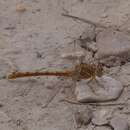en
names in breadcrumbs


Onychogomphus costae és un odonat anisòpter de la família dels gòmfids.[1]
Es tracta d'un endemisme de la península Ibèrica i nord-oest d'Àfrica: es troba a Tunísia, Algèria, Marroc, Portugal i Espanya. En general, és rara en gran part de la seva àrea de distribució però comuna en algunes localitats.[2][1]
A Catalunya se n'han trobat alguns exemplars a La Noguera.[3]
És una espècie que sol passar inadvertida degut als seva coloració críptica (marró clara) i a la seva grandària discreta, d'entre 43 i 46 mm de longitud entre el cap i l'extrem abdominal.[1]
Viuen en rius i rerols amb la llera de sorra o grava. Probablement prefereixi hàbitats estacionals, on es formin basses al baixar el nivell de l'aigua.[1] També pot acceptar aigües salobres.[2] El seu comportament és poc conegut; acostumen a romandre llargs períodes allunyats de l'aigua.[1]
Al Magreb s'han detectat individus des de maig fins a l'agost, mentre que a zones com Extremadura, només vola al juny i juliol.[1]
Gwas neidr o deulu'r Gomphidae (neu'r 'Gweision neidr tindrom') yw'r Onychogomphus costae. Fel llawer o weision neidr, ei gynefin yw pyllau o ddŵr, llynnoedd, nentydd neu afonydd.
Gwas neidr o deulu'r Gomphidae (neu'r 'Gweision neidr tindrom') yw'r Onychogomphus costae. Fel llawer o weision neidr, ei gynefin yw pyllau o ddŵr, llynnoedd, nentydd neu afonydd.
Onychogomphus costae is a species of dragonfly in the family Gomphidae. It is found in Algeria, Morocco, Portugal, Spain, and Tunisia. Its natural habitat is rivers. It is threatened by habitat loss.
Onychogomphus costae is a species of dragonfly in the family Gomphidae. It is found in Algeria, Morocco, Portugal, Spain, and Tunisia. Its natural habitat is rivers. It is threatened by habitat loss.
Onychogomphus costae Onychogomphus generoko burruntzia da, hego-mendebaldeko Europan eta ipar-mendebaldeko Afrikan endemikoa dena[1]. Ibaietan bizi den burruntzi hau bere habitataren galera dela eta mehatxaturik dago.
Basa eta Itsas Fauna eta Landaredian Arriskuan dauden Espezieen Euskadiko Zerrendaren bakanen kategorian sartu zuten.[2]
Onychogomphus costae Onychogomphus generoko burruntzia da, hego-mendebaldeko Europan eta ipar-mendebaldeko Afrikan endemikoa dena. Ibaietan bizi den burruntzi hau bere habitataren galera dela eta mehatxaturik dago.
Basa eta Itsas Fauna eta Landaredian Arriskuan dauden Espezieen Euskadiko Zerrendaren bakanen kategorian sartu zuten.
De moorse tanglibel (Onychogomphus costae) is een libellensoort uit de familie van de rombouten (Gomphidae), onderorde echte libellen (Anisoptera).[2]
De moorse tanglibel staat op de Rode Lijst van de IUCN als gevoelig, beoordelingsjaar 2007, de trend van de populatie is volgens de IUCN dalend. De soort komt voor in Algerije, Marokko, Tunesië en het zuidoosten van het Iberisch Schiereiland.[1]
De wetenschappelijke naam van de soort is voor het eerst geldig gepubliceerd in 1885 door Selys.
Bronnen, noten en/of referentiesOnychogomphus costae – gatunek ważki z rodzaju Onychogomphus należącego do rodziny gadziogłówkowatych.
Onychogomphus costae – gatunek ważki z rodzaju Onychogomphus należącego do rodziny gadziogłówkowatych.
Onychogomphus costae é uma espécie de libelinha da família Gomphidae.
Pode ser encontrada nos seguintes países: Argélia, Marrocos, Portugal, Espanha e Tunísia.
Os seus habitats naturais são: rios.
Está ameaçada por perda de habitat.
Onychogomphus costae é uma espécie de libelinha da família Gomphidae.
Pode ser encontrada nos seguintes países: Argélia, Marrocos, Portugal, Espanha e Tunísia.
Os seus habitats naturais são: rios.
Está ameaçada por perda de habitat.
Onychogomphus costae là một loài chuồn chuồn ngô thuộc họ Gomphidae. Nó được tìm thấy ở Algérie, Maroc, Bồ Đào Nha, Tây Ban Nha, và Tunisia. Môi trường sống tự nhiên của nó là các con sông. Nó bị đe dọa do mất môi trường sống.
Onychogomphus costae là một loài chuồn chuồn ngô thuộc họ Gomphidae. Nó được tìm thấy ở Algérie, Maroc, Bồ Đào Nha, Tây Ban Nha, và Tunisia. Môi trường sống tự nhiên của nó là các con sông. Nó bị đe dọa do mất môi trường sống.